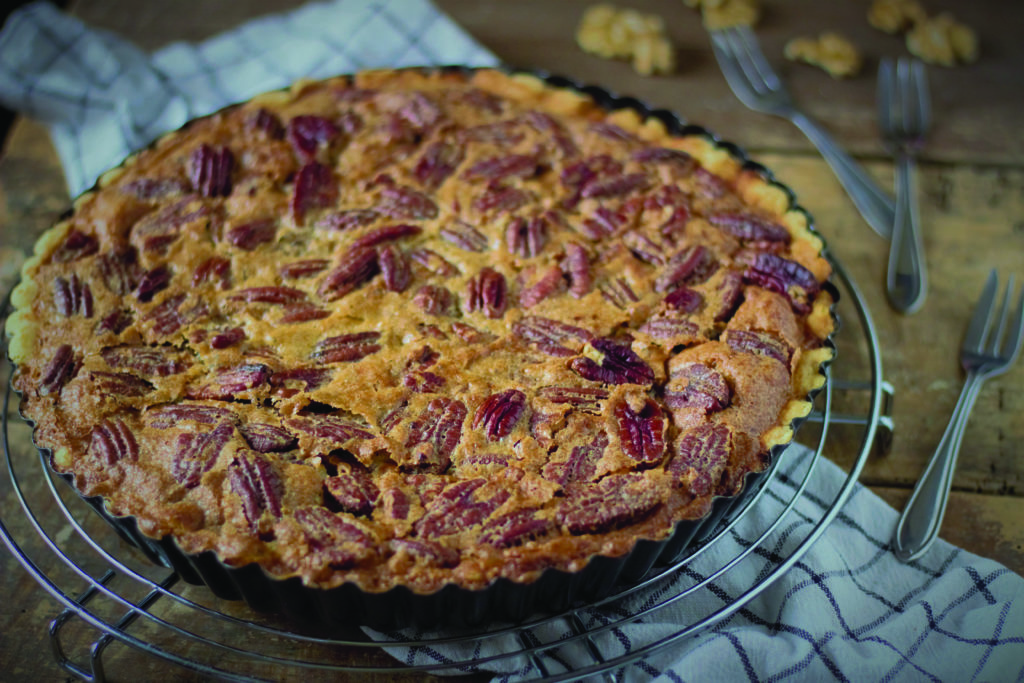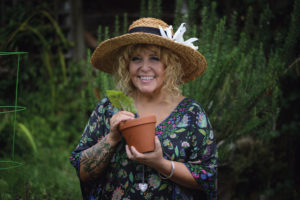An addition to your garden that you may not have considered is nuts.
There are a few tree nuts that are easily grown in temperate areas, including the Central Coast and while it is true that nut trees take a longer time to fruit, in the meantime you will have a beautiful tree that will provide shade in summer (some year-round) and design interest in your garden.
Right now, in winter, you can find bare-rooted trees as well as potted up varieties at your local nurseries and online. Ready to go nuts?
Let’s find out more with my ‘starter list’ for the nut curious.
Almonds (Prunus dulcis)
Though two varieties are needed for pollination, there are ‘self-pollinating’ varieties available and grafted trees are probably the best choice for a hardy plant.
They can grow over 3m in height but will tolerate pruning down to 2m to contain size.
Almonds like full sun, a loamy well-drained soil with a pH level of 6.5 – 7.3 and moderate watering that suits the season.
They are bare in winter and fruit harvesting time will be mid to late autumn. 2 – 3 years until harvest.
Suggested variety: Self-pollinating Papershell (dwarf).
Nut Fact – Chestnuts are the only nut that contains vitamin C. The oldest chestnut tree is believed to be the ‘Hundred Horse Tree’ in Sicily dated between 2,000 and 4,000 years old.
Hazelnuts (Corylus avellana)
You will need two varieties and of these trees for pollination and ensure that you have compatible types.
A chat with your supplier will give you the right information.
It’s a big tree, some growing up to 5m in height, but some types are smaller.
They will tolerate semi-shade but prefer full sun for greater yields and soil needs to be friable and more to the sandy side with a pH level of 6 – 6.5.
It’s deciduous, bare in winter, and watering needs are moderate.
Harvest in early autumn and it’s 2 – 3 years until first harvest.
Suggested varieties: Lewis, Halls Giant, American White.
Nut Fact – Hazelnuts are high in the amino acids that help you sleep. Nutella, the hazelnut-based spread, has different recipes in most countries to suit local tastes and availability of product.
Macadamia (Macadamia tetraohylla)
Self-pollinating and an Australian native, this tree is evergreen.
Will grow to 10m and once established, prefer semi shade and requires moderate watering to suit the season.
They are not frost tolerant and soil needs to be deep and very fertile, well drained loam with a pH level of 6.6 – 7.3. Harvest from late summer through until mid-autumn and time to first harvest is about 2 to 3 years.
Suggested varieties: dwarf, Daddow.
Nut Fact – Macadamias are one of the few sources of palmitoleic acids which promotes skin, nail and hair health. Some Indigenous tribes used them as gifts to swap for other items.
Pecan (Cara illinoineniensis)
You will need a pollinator of a compatible and different variety for successful pecan growing.
They can grow up to 10m in height and are deciduous with a good frost tolerance.
Soil needs to be on sandy side, very good drainage is essential and a pH level of 6. 6 to 7.3 is best.
Harvest from mid-autumn until early winter.
They will take 4 to 5 years until first harvest. Suggested varieties: Apache, Pawnee, Tejas
Nut Facts – Pecans are helpful in reducing inflammation as they are high in Omeg-3 fats. Pecans only produce their nuts once every two years.
Walnuts (Juglans spp.)
A self-pollinating tree that can grow up to 30m in height but there are shorter types available and will require a full sun position.
It is a frost-tolerant, deciduous tree that needs moderate watering as the seasons dictate.
Drainage of soil is important and needs to be very good with a soil type that is loamy and fertile Harvest late autumn to mid-winter, and it is about 4 to 5 years until first harvest.
Suggested varieties: Paradox, Chandler, Black.
Nut Fact – Walnuts are high in alpha-linolenic acid which is excellent for brain and heart health.
These are the oldest known tree food dating back 7,000BC.
Resources:
To find your nut trees, along with local nurseries and garden centres, try: Diggers Club: diggers.com.au, Daley’s Fruit: daleysfruit.com.au, Heritage Fruit: heritagefruittrees.com.au
Purchase local nuts from: The Pecan Lady: peacanlady.com.au and at times, gosfordcityfarmersmarket.com.au
TIME TO GET YOUR HANDS DIRTY
Your annuals are going to benefit from a feeding of liquid fertiliser every fortnight at the moment and it’s hydrangea pruning time as well.
If you are wanting to change their colour, now is also the time.
It’s all about changing the pH level of the soil and this can be done by adding aluminium sulphate to obtain more blue shades or lime for pinks.
You could plant artichokes, asparagus crowns, beetroot, broad beans, cabbage, carrot, English spinach, lettuce, mustard, late season onions, parsnip, peas, potatoes, radish, rhubarb crowns, salsify, silverbeet, English daisy, delphinium, dianthus, gloxinia, gypsophila, marigold, roses, spider flower, statice
PLANT HAPPENINGS
Unfortunately due to the continued Covid restrictions in person events have been cancelled or postponed.
Here are a few interesting instructional courses that are available online:
How to Be a Gardener: www.bbc.co.uk/gardening/htbg
Flower Gardening: pyours.com/product/video-flower-gardening-simplified
Organic Gardening: smilinggardener.com/organic-gardening
If you have an event, meeting or news, contact me on: gardeningcentralcoast@gmail.com for your free listing.
Websites you just have to see:
The Spruce: although the information is for the Northern Hemisphere, just flip it around or considered our temperate climate when reading but there are lots of resources that are worth it: thespruce.com
Plants Are the Strangest People: For houseplant lovers and it is a little on the weird side plantsarethestrangestpeople.blogspot.com
Gardening Know How: gardeningknowhow.com
Kids Gardening: kidsgardening.org/garden-activities/
DOWN IN MY GARDEN
With lockdown it has been difficult for me to get to your gardens, but I am able to interview you over the phone and have you send me pictures for our gardening page.
I don’t have to publish your suburb or your personal photos if that’s what you would prefer but we do want to see your garden!
I’m very keen for private gardens, community gardens, memorial, workplace, indoors or out, any sort of garden and any level of skill from complete to beginner to master green thumbs. Contact me on gardeningcentralcoast@gmail.com and we can have a chat.
RECIPE – COASTIE NUT PIE
You can use any nuts for this delicious heart-warming winter open crust pie. You could use single nuts or combinations of your favourites.
Serves ten
Ingredients:
- Approx. 24cm pie tin with removable base
- 2 x short crust pastry sheets (or make your own)
- 2 cups of coarsely chopped nuts of your choice
- 1 ¼ cup sugar
- ¼ cup of spiced rum or water
- 2/3 cup thickened cream
- 2 tablespoons butter
- 1 tablespoon honey
- 1 teaspoon vanilla extract
Method:
- Preheat oven to 190C and lightly grease the pie tin and line with baking paper if desired.
- Cover the base and sides of the pie tin with the pastry, pierce all over with a fork and bake for around 15 to 20 minutes until it is lightly golden.
- Keep an eye on it and pierce any bubbles that form while baking.
- Take out of oven and increase temperature to 200C
- Heat the sugar and the spiced rum (or water) in a very large saucepan over medium heat while continually stirring until all the sugar has dissolved.
- Cease stirring and increase the heat and let boil until a caramel colour has been achieved.
- Stir lightly occasional to prevent sticking – this will take about 10 mins.
- Take the heat back down to medium and once it stops bubbling, slowly pour in thickened cream while stirring until the mixture is smooth.
- Pop in the honey, butter (chopped) and vanilla and mix until butter melts and then fold in the nuts.
- Pour this mixture into the pie case and return to oven to bake for 20 minutes. Cool before serving.
Cheralyn Darcey is a gardening author, community garden coordinator and along with Pete Little, hosts ‘At Home with The Gardening Gang’ 8 – 10am every Saturday on Coast FM 96.3.





